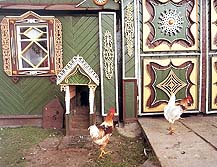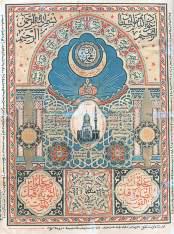Architecture
 | |
| V.S.Turin. The view of the Fortress from the Kazanka river 1834 |
 | |
Russian craftsmen employed mainly woodcarving, whereas the Tatars used rich color palette. Historian M.Hudyakov wrote: "Color is the basic element of Tatar art, the affinity of the Tatars to the East becomes apparent in this application of decorative painting. The Tatars pay special attention to the gate painting ..." The basic color spectrum is nearly always the same: green, light-blue, white and yellow. All colors were taken pure, without half-tints, the gate painting being rich and bright.
However, both color and patterned carving were important elements of the dwelling decoration. The images of the sun and geometrical signs, birds, colors and mythological symbols can be still seen on old houses and gates.
 | |
| Shamail "Munadzhad" about the Faith in God |
The mid-18th century became the beginning of a new stage in development of Tatar architecture. It was characterized by a close contact to Russian culture and consequent acquisition of certain elements of West-European culture. The architecture of rich Tatar houses and mosques acquired stylistic characteristics of Baroque and classicism, at the same time maintaining traditional features of planning and forms of Bulgar architecture.